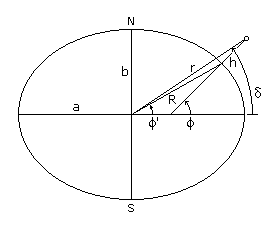For the last week or so, I have been teaching myself orbital mechanics within the context of Braeunig's Rocket and Space Technology.
I noticed a symbol, $\phi '$, and was wondering what context that was used in? I think it is an angle measurement, but I know that it is almost equal to the semi-major axis on earth.
From the box labeled Geodetic Latitude, Geocentric Latitude, and Declination, found about half way down after selecting Orbital Mechanics here.

